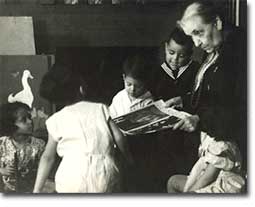38e. Religious Revival: The "Social Gospel"

Jane Addams, founder of Hull House in Chicago
The Protestant churches of America feared the worst. Although the population of America was growing by leaps and bounds, there were many empty seats in the pews of urban Protestant churches. Middle-class churchgoers were ever faithful, but large numbers of workers were starting to lose faith in the local church. The old-style heaven and hell sermons just seemed irrelevant to those who toiled long, long hours for small, small wages.
Immigration swelled the ranks of Roman Catholic churches. Eastern Orthodox churches and Jewish synagogues were sprouting up everywhere. At the same time, many cities reported the loss of Protestant congregations. They would have to face this challenge or perish.
Preaching for Politics
Out of this concern grew the social gospel movement. Progressive-minded preachers began to tie the teachings of the church with contemporary problems. Christian virtue, they declared, demanded a redress of poverty and despair on earth.
Many ministers became politically active. Washington Gladden, the most prominent of the social gospel ministers, supported the workers' right to strike in the wake of the Great Upheaval of 1877. Ministers called for an end to child labor, the enactment of temperance laws, and civil service reform.
Liberal churches such as the Congregationalists and the Unitarians led the way, but the movement spread to many sects. Middle class women became particularly active in the arena of social reform.
At the same time, a wave of urban revivalist preachers swept the nation's cities. The most renowned, Dwight Lyman Moody, was a shoe salesman who took his fiery oratory on the road. As he traveled from city to city, he attracted crowds large enough to affect local traffic patterns.
The Young Men's Christian Association and the Young Women's Christian Association were formed to address the problems of urban youth. Two new sects formed. Mary Baker Eddy founded the Christian Science denomination. She tried to reconcile religion and science by preaching that faith was a means to cure evils such as disease. The Salvation Army crossed the Atlantic from England and provided free soup for the hungry.
The Third Great Awakening
The changes were profound. Many historians call this period in the history of American religion the Third Great Awakening. Like the first two awakenings, it was characterized by revival and reform. The temperance movement and the settlement house movement were both affected by church activism. The chief difference between this movement and those of an earlier era was location. These changes in religion transpired because of urban realities, underscoring the social impact of the new American city.






